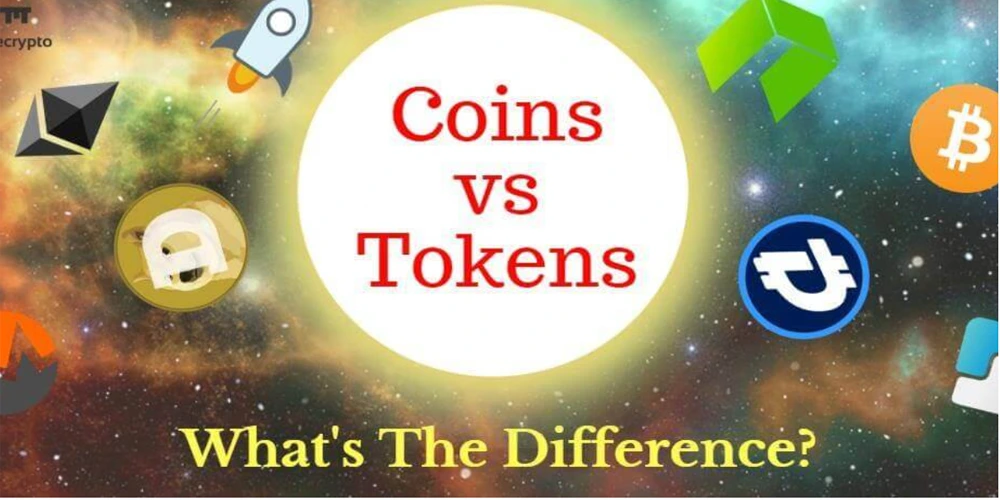The market is flooded with thousands of cryptocurrencies, often interchangeably labelled as ‘coins’ or ‘tokens.’ Despite sharing fundamental principles in blockchain, there exist distinct differences between cryptocurrency coins and tokens. This article delves into the concept of cryptocurrencies, examining the underlying technology driving them. Furthermore, it explores various types of crypto assets, encompassing coins and tokens, elucidating the contrasts and similarities between these entities.
What exactly do we mean by cryptocurrencies?
Cryptocurrencies are like digital money on the internet. Unlike regular money that you can hold in your hand, cryptocurrencies are made up of computer code and are used to buy things online. People who own cryptocurrencies can also earn money through things like staking and yield farming. Additionally, cryptocurrencies use a special technology called blockchain, which gives each cryptocurrency its own set of rules. For instance, it decides how much of the cryptocurrency exists and what you can do with it. The value of a cryptocurrency depends on how much people want it and what it can be used for.
What exactly is blockchain?
Blockchain, launched in 2009, is a form of distributed ledger technology (DLT) recording secure and immutable financial transactions. Similar to inscribing on stone, confirmed transactions are publicly accessible yet maintain private identities through cryptography. Operating on a network of nodes, each responsible for transaction verification, blockchain rewards nodes with cryptocurrency for maintaining the network. Validated transactions are grouped into blocks and added to the blockchain, enabling peer-to-peer transactions without intermediaries.
Understanding Cryptocurrency Coins
In order to transfer value or information, each blockchain network will have its own native coin on the payments layer. For example, Ethereum (ETH) is the native coin of the Ethereum blockchain network. Further, cryptocurrency coins are often used to incentivise the nodes in the network processing the transactions. Coins are typically used as a medium of exchange for assets and services available on a blockchain network.
Cryptocurrency coins are generally mined into existence upon the completion of new blocks being added to the blockchain. Additionally, the native coin is often used to cover the computational gas costs of processing transactions on a blockchain. There is generally a fixed supply of coins to create scarcity and value to a project. For example, the leading blockchain network, Bitcoin, has a maximum capped supply of 21 million coins. This amount is embedded in the protocol and would require a majority consensus of the Bitcoin community to adjust or increase the supply.
Digital Tokens in Cryptocurrency
Cryptocurrency tokens are different from coins. While coins are specific to a blockchain, tokens are special digital assets that work on top of a network. For example, MATIC is an ERC-20 token that runs on the Ethereum blockchain. Different blockchains have different standards for tokens, like the BEP-20 standard on Binance Smart Chain. Think of these standards as recipes or frameworks that let tokens interact with various decentralised protocols, such as wallets or exchanges, in a blockchain system. Tokens allow users to use different decentralised applications (Dapps) on various chains.
Cryptocurrency tokens can do many things, often offering more diverse functions than coins. This may include roles in governance and security using smart contracts. Anyone can create a cryptocurrency token on a blockchain. What gives a token value is its usefulness and design, including how much is available and how much people want it. The total supply of a token is set when it’s launched and can be distributed through methods like initial coin offerings (ICOs), token sales, or airdrops.
Distinguishing Between Cryptocurrency Coins and Tokens
When engaging with cryptocurrencies, whether they’re tokens or coins, it’s essential to be familiar with a Web3 wallet. A Web3 wallet serves as a digital space for storing crypto assets on the blockchain. However, there’s a distinction in the roles of coins and tokens within the blockchain, as outlined below:
Coins:
- Native assets of blockchain networks
- Mainly used as a medium of exchange or store of value
- Issued through the process of mining new blocks on the blockchain
- Typically have a fixed maximum supply
- Accessible on most centralised exchanges (CEXs)
Tokens:
- Exist on top of blockchain networks
- Possess a variety of utilities within decentralised applications (Dapps)
- Can be issued all at once or through token sales
- Supply can be adjusted based on project design and demands
- Available on decentralised exchanges (DEXs)
Functional and Secure Tokens
Security tokens are digital currencies that signify ownership of an asset or project. In contrast, there are cryptocurrencies known as ‘utility tokens’ that enable holders to utilize specific services or applications within a blockchain ecosystem. Unlike security tokens, utility tokens do not grant an investment stake in a project. Instead, they can be utilized as rewards in loyalty programs, in-game currencies, or instruments for voting in decentralised autonomous organisations (DAOs).
Stablecoins
Although termed ‘stablecoins,’ most of these assets are, in fact, tokens rather than coins. Notably, stablecoins such as USDC and USDT adhere to the Ethereum ERC-20 token standard. The naming convention originates from their widespread use as a medium of exchange, akin to native blockchain coins. However, stablecoins operate through smart contracts on platforms like Ethereum or other blockchains. Typically, these tokens are supported by US dollars or other assets to maintain a peg of $1 and do not possess their standalone blockchain.
Understanding the Distinction Between Coins and Tokens: A Recap
In the realm of crypto, the terms ‘token’ and ‘coin’ are frequently interchanged, yet crucial distinctions exist between the two. These disparities encompass aspects like issuance, liquidity, and utility of the assets. Grasping the similarities and disparities between coins and tokens empowers investors to make more informed decisions about their investments.
Want More Cutting-Edge Crypto News?
Follow Us: X TikTok Instagram Telegram LinkedIn
Sign up to our newsletter at the bottom of the page
Check Out Our Top 10 Crypto Currencies of 2023
This article is intended for educational purposes and is not financial advice.













